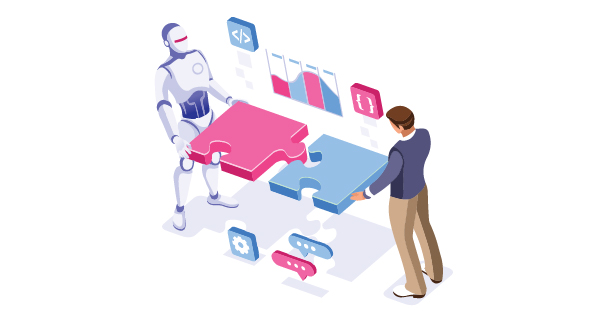June 23, 2020
Artificial intelligence (AI) and machine learning (ML) emerged as breakaway technologies almost a decade back, but their industry-wide application has seen a major upswing in the last few years. The AI market is expected to breach the $200 billion mark by 2026, having grown at a CAGR of 33.1% since 2018, when the market was worth about $20 billion. A tenfold growth in eight years is testament to the industrial reliance on AI and its ever-growing scope. Further innovations in the fields of natural language processing (NLP), big data, analytics, and automation will augment the expansive purview of AI.
Simplifying IT operations with AI
As global enterprises continue emphasizing on the deployment of smart machines and simplification of operating processes, one of the key focus areas for them will be IT management. With the increasing proliferation of smart devices, expanding remote workforce, and evolving enterprise needs, the pressure on IT teams is fast reaching the breaking point. Sustainable IT practices that are contingency proof and less reliant on human intervention are fast emerging as a key competitive differentiator. That is precisely what AI promises to do in form of AI operations (AI Ops).
The concept of AI Ops focuses on combining human and machine intelligence by applying AI to the traditional, simple automation and manually executed IT operations (IT Ops). Enterprises are gradually implementing AI Ops across their enterprise IT environment with the aim of gaining complete and real-time visibility of the performance and management of their IT assets. AI Ops is also offering greater clarity on the health of the IT systems in use. In short, as new-age enterprises expedite their digital transformation initiatives, especially in the post-pandemic world, AI Ops will play a critical role in creating a sustainable and agile IT ecosystem that is prepared for contingencies.

Operational continuity is paramount
In a heavily-digitized paradigm, businesses rely squarely on their IT efficiencies to ensure operational continuity. Even when unforeseeable contingencies disrupt operations, efficient IT management ensures quick recovery. Maintaining uptime at any cost is pivotal to company fortunes as every minute of unscheduled downtime results in losses that can be impossible to recover from. Traditional IT Ops are fast turning inadequate since their primary task is to create and maintain IT environments with heavy focus on uptime, regardless of changes to the infrastructure or applications.
With the help of machine implemented data aggregation and analysis, AI Ops identifies causality and evaluates situations appropriately in order to take predictive measures. Apart from enhanced situational understanding, AI Ops also ensures intelligent alerting by analyzing relevant datasets as per situational requirements. This helps in the prioritization of problem-solving and prevents frequent breakdowns.
Compared to traditional IT Ops, AI Ops is more capable of cohort analysis. It can analyze structured and unstructured data quickly from various sources and applications across the IT environment. This enables prompt decision making and prevention of system failures. Automation is another significant value addition of AI Ops. Certain IT tasks, such as root cause analysis, can be entrusted to AI tools, ensuring prioritization and faster resolution of problems. Analysis of historical data also helps formulate the best and the fastest remediation option.
The twofold deployment journey
In today’s digital paradigm that relies heavily on large heterogeneous infrastructures, the “find and fix it” approach taken by IT Ops is not nearly enough. The sheer number of applications creates complexities that traditional IT tools and personnel cannot support. Traditional IT management practices include the use of war rooms, which involves setting up scheduled or emergency meetings to identify problems plaguing IT systems and processes. However, studies show that the war room process is neither cost effective, nor does it always achieve timely and desired results. Bringing together human resources from across departments is in itself a time-consuming task, and to then reach timely resolution only increases the turnaround.

Due to various shortcomings of traditional means, enterprises need to swiftly migrate to AI Ops from IT Ops without compromising operations. The enterprise-wide deployment of AI Ops is a twofold process, and it digitally vitalizes the conventional “find and fix it” approach to slash time to value while increasing overall productivity considerably.
- For traditional IT Ops, the finding phases requires pinpointed identification of probable root cause (PRC) for the anomaly in question. Manual detection of issues is time consuming and error prone. But, with AI Ops, the aim is to improve the speed of finding and fixing anomalies by incorporating intelligent algorithms and methods that augment products and IT Ops tools. AI is particularly effective at suppressing IT noise, avoiding duplications, eliminating symptoms, and identifying PRCs. As a result, AI Ops methodologies are able to identify problems faster and can initiate manual or automated remediation.
- However, more importantly, the second phase of the deployment strategy ensures use of intelligent tools that are able to identify problems before they happen and take corrective measures in advance to prevent downtime. By using AI abilities to detect and correlate data, the AI Ops tools predict failures. This predictive capability anticipates IT problems and plays a crucial role in considerably reducing or entirely eliminating the time taken to find anomalies. The predictive capabilities of AI will gradually expand the scope of AI Ops across all aspects of IT. It will result in users no longer needing to provide information of a problem; the problem will be automatically detected and fixed.
Making IT collaborative and agile
One of the key takeaways of applying AI capabilities to IT management is creating a holistic IT environment that thrives on collaboration and makes IT practices agile and future ready. In order to create a more collaborative and agile IT spectrum, enterprises will have to take an intelligent approach to migrate from IT Ops to AI Ops. A rapid shift is key to creating a well-rounded IT ecosystem.
It is important for enterprises to observe their IT needs and use the right connections for their on-premise cloud environments – local, hybrid, or multi-cloud. Once connected, ingestion ensures a swift move to AI Ops. Once it finds its way into the IT environment, AI Ops ensures that devices work in unison and silently. With all the devices and applications running, AI Ops locates the susceptible systems or components and isolate them for redressal instead of rebooting the entire system. Contextual understanding is the key. For the IT environment to function like clockwork, AI Ops breaks down silos and imbibes greater cohesion and collaboration. Intelligent tooling ensures seamless communication and informed decision making. Ultimately, with all the data flow and smart analytics, responses are the final step in the AI Ops process. These responses are automated to save time and prevent human errors.
With a heavily-digitized future beckoning, IT management of new-age enterprises will have to employ AI Ops in order to make a complete transformation. AI has much to offer to enterprises, and scaling operations with the help of AI Ops is only one of those offerings.

Clayton Ching
Clayton Ching is Global Head of Product Management for DRYiCE Software. He brings over 25 years setting the strategic product directions and managing extensive portfolios for enterprise IT systems, service management, systems, applications and network management portfolios. Clayton also has held senior management positions at TCS Digitate, Splunk, IBM, Micromuse, Boundary and Candle Corporation.

